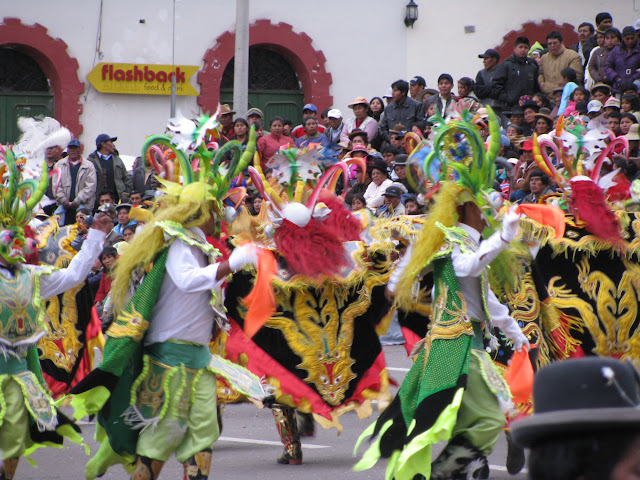The gateway for Lake Titicaca’s islands, the tiny port of Puno hugs the sacred Inca lake’s northwestern shores. Few colonial buildings remain in town, though Puno’s friendly streets bustle with local women garbed in multi-layer dresses and bowler hats. We take a bus from Copacabana and spend one night here just in time to be a part of a colourful celebration. The Peruvian’s, like the Bolivian’s, love their fiestas.
The next day we hop on another bus for a 10-hour journey bound for the capital city of Cuzco. At our lunch stop we enjoy a local band playing tradition Andean music so much we come away with one of their CDs.
Racqui, the Temple of the Sun, is another stop on our journey.
The high-flying city of Cuzco sits at a 3300m crossroads of centuries-old Andean tradition and modern Peruvian life. As the continent’s oldest continuously inhabited city, it was once the inca empire’s foremost stronghold, and is now both the undisputed archaeological capital of the Americas as well on one of the continent’s most staunchly preserved colonial living museums.
Colonial arcades surround the plaza, which was the heart of the ancient Inca capital.
Massive Inca-built walls line steep, narrow cobblestone streets and plazas thronged with the descendants of the might Incas and Spanish conquistadors—who hobble about in colourful traditional wares among the hustle and bustle of contemporary cuzqueños making a living from the town’s present-day life-blood: tourism. And lots of it.
The perfect symmetry and construction of Incan architecture.
The Inca site of Qorikancha forms the base of the colonial church of Iglesia de Santo Domingo. In Inca times, Qorikancha was literally covered with gold. It was not only used for religious rites, but was also an observatory from which priests monitored major celestial activities.
Tambomachay is a beautifully wrought ceremonial bath, still channeling clear spring water that earns it the title El Bano del Inca.
We meet an adorable, hairless Peruvian dog. Peruvian dogs are said to cure asthma within a week.
Tim happens upon another street festival, this one for the children.
The adobe Iglesia de San Blas has a pulpit which some call the finest example of colonial woodcarving in the Americas. It’s the creator’s skull that legend says is nestled in the topmost part.
Inside a Spanish colonial mansion, the dramatically curated Museo de Arte Precolumbio showcases a stunningly varied collection of priceless archaeological pieces.
This wooden sculpture of a chimu idol dates from 1300-1532 A.D.
A beautiful, simple anthropomorphic vessel dating from 1250 B.C. to 1 A.D.
Ceremonial funerary mask, 1250 B.C. to 1 A.D.
Taking almost 100 years to build, Cuzco’s cathedral sits on the site of the Inca Viracocha’s palace and was erected using blocks from Saqsaywaman.
We visit the Centro de Textiles Tradicionales del Cusco, which contains a shop selling fine textiles, a museum and demonstrations of the art of weaving.
Sandi can’t resist a hand-stitched, antique-styled Pachamama doll, a good luck symbol and only $2!






















































No comments:
Post a Comment